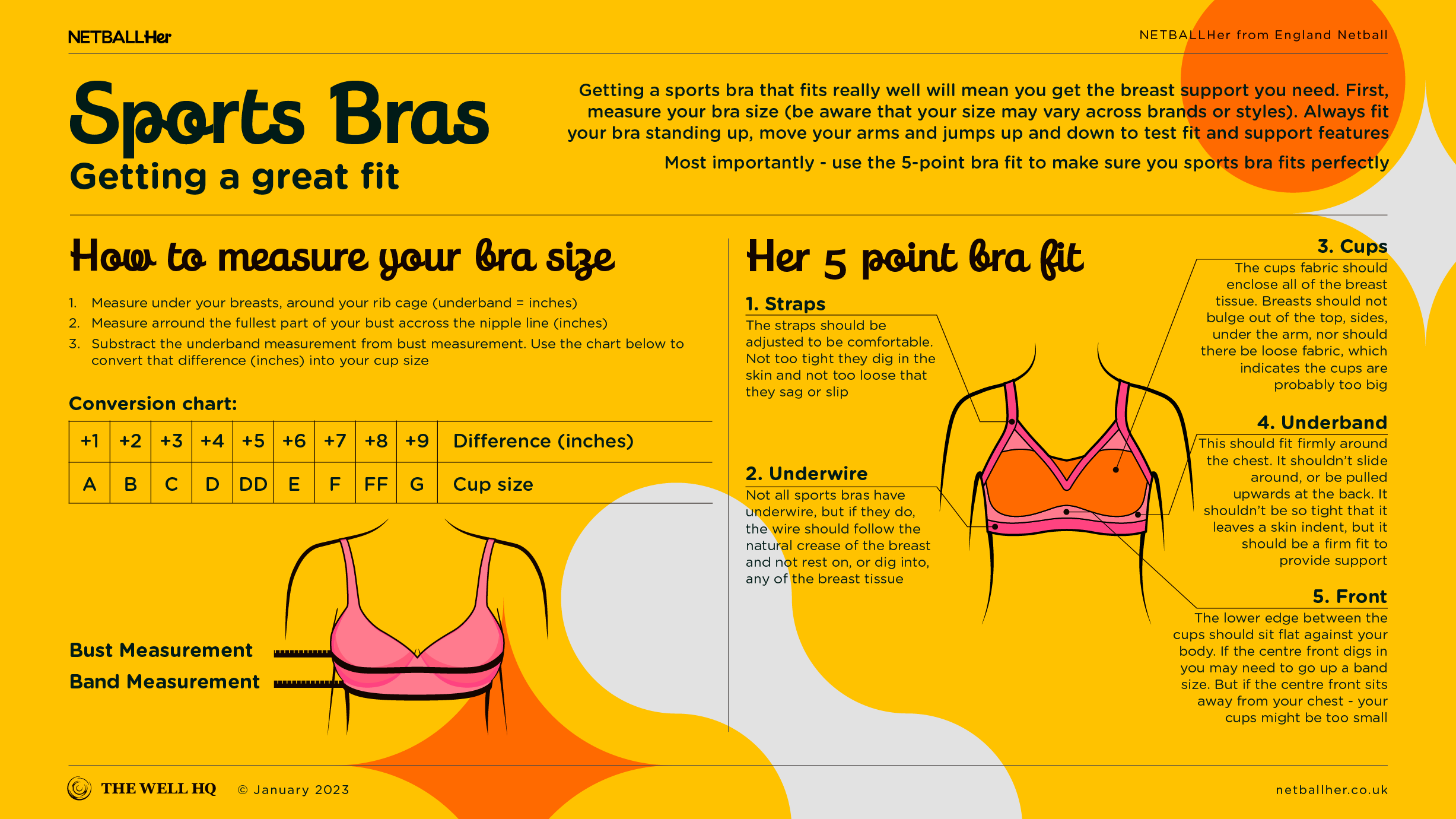Click play for an audio readthrough of this article
Puberty’s a bit of a journey and, quite honestly, the system doesn’t provide a map.
As parents, coaches and supporters – it’s mostly on us.
As girls hit puberty, which can start as young as eight-years-old, developing breasts are a defining feature. Girls go from having no breasts to adult-size breasts in just a few years, yet during that time there’s currently no education which adequately focuses on breasts and how to look after them.
In a study by the University of Portsmouth Research Group in Breast Health, 87% of teens reported that a breast issue (pain, movement, bra fit, embarrassment) was a barrier to them doing exercise. That’s nearly nine in every ten … it’s more than a netball team’s worth.
But we also know just one hour of education about breast development – and how to support breasts during exercise – is enough to reduce girls’ embarrassment and instil more confidence in areas such as choosing the right bra. Just one hour and girls feel empowered – they actually want to do more exercise.
Given netball is a powerful platform where we can start these conversations and drive progress, we have an opportunity now to give girls the information — and the inspiration – they need to ensure their bodies don’t hold them back from the sport they love.
Messages and sports bras
When speaking to younger girls, a great starting point is the sheer importance of breast support. A good sports bra is the answer to breast discomfort, it’ll make exercise feel easier and it’ll even reduce embarrassment. It’ll even improve a female’s performance on court because her movement isn’t compromised.
These are all powerful messages to get across, especially early on.
Younger girls should also know the different styles of sports bra (compression, encapsulation, combination) and which best suit smaller and larger breasts.
A how-to session on measuring their breast size can be especially empowering as there’s nothing more embarrassing for a girl – who’s still getting to know her body – standing in a changing room as a woman measures her bust. It’s just unnecessary when you can easily do it at home.
Cost, comfort and communal space
Sports bras don’t have to be expensive. Sure, when buying for developing breasts – where the size changes more frequently – a sports bra may need to be replaced a few times.
But note that a bra bought on the high street can be just as effective as one purchased from a premium brand. As long as a female (and this is true at any age) is in the right style of bra and it fits well … she’s in a great place.
Here’s a video on getting the right fit.
Do also think through the practicalities of a younger girl changing into her sports bra. While most gyms or leisure centres have separate cubicles, some places – think schools and older venues – might not. For a self-conscious girl, changing into a sports bra (which she may not yet be an expert in) in a communal space ain’t ideal.
Far from knowing that a sports bra is important and having one that fits, the biggest barrier to a girl playing netball in the right bra might be that she has nowhere to (comfortably) change into it.
If such a barrier could be an issue then this is where bra design, adjustability and fabric are all really important. If her bra is comfortable and adjustable enough to stay in all day, then she can pop it on in the morning and still enjoy great breast support come netball time, avoiding the awkward changing-in-public bit.
Things to look out for as you shop
Before our list of things to think about, here’s our first-sports-bra picks. Getting the right bra isn’t a one-size-fits all type situation. But there are certainly bra’s which have been well designed for developing breasts and making young girls feel comfortable.
Please note – no one gets any commission or revenue if you buy through these links. We genuinely think these are the best of what’s out there.
In most cases we link you straight to the manufacturer but please do your own research, particularly when it comes to price!
Fabric
The fabric shouldn’t have lots of stretch in it. If it does then it won’t offer good breast support as you move. T-shirt style (cotton-rich) fabrics, for example, are a poor choice as they stretch too much and offer little-to-no support. Also, avoid straightforward stretchy crop tops as there’s nothing technical or thoughtful about these products and they provide virtually zero in the support department. Standard polyester, too, is best avoided.
Instead, look for polyamide/ nylon fabrics as they’re very strong with good compression, and usually have a soft skin-friendly feel. Elastane/ lycra is also a good and stretchy fabric that offers compression, strength and the right level of elasticity.
Underbands
The underband actually provides most of the breast support in a bra so it needs to fit really well, and be strong enough for the job. But strong elastic does not mean tight elastic.
If you stretch the underband when you’re not wearing the bra you’ll get an idea of the strength of the elastic used. It shouldn’t be too stretchy.
An adjustable underband is even better. Whether it uses clasps, Velcro or hooks, the ability to tighten and loosen the underband means it can be adjusted to a lesser tension for sitting in class, say, and then tightened up for netball later on.
Straps
Always try to find straps that can be adjusted. As girls grow their chest measurements will change but cup size and body size don’t grow in unison. Having great adjustability means responding to such changes quickly and effectively.
Think long term
If your sports bra has a clasp at the back of the underband (most bras have three hooks), Make sure at first your bra is snug even on the loosest hook, since this means it will fit better for longer, because you’ll be able to switch to the other hooks as time goes on and the band stretches due to washing, wear and tear. Research shows that wearing and washing a sports bra 25 times can reduce its breast support by 30%, so give yourself some room to keep it fitting well.
Posture
There’s a strong suggestion that racer back bras – that’s the ones with an x shape at the back- are best for posture and support. This is great news for girls who spend half their day in class at a desk … or women who do the same at work.
A well-fitting sports bra can also help stop you hunching over which, apart from being bad for your back and neck, increases levels of the stress hormone, cortisol.
Padding
Removable padding can allow for a more personalised fit. Pads in sports bras aren’t meant to make the bust look bigger but to improve fit and support. Pads are especially useful for girls whose breasts are developing at different rates and so look uneven for a time.
Using a pad in one cup can help to even out asymmetry, and reduce any anxiety or embarrassment associated with it.
Encapsulation bras & stitching
Encapsulation bras will be best for supporting girls who have developed a larger breast size, but look out for the stitching on the inside of the cups.
Cups’ stitching can sometimes be rough and therefore itchy, especially during movement and especially if worn over a long period of time. Developing breasts are often more sensitive … so itchy stitches aren’t the way to go.
All-day-wear?
If changing into a sports bra is a challenge then think about a bra that’s comfortable enough to wear all day. So if it digs in, or doesn’t look right, or it’s not the right colour for wearing under a school shirt, then don’t settle. Find one that can tick the all-day-long boxes; that’s comfortable, adjustable and right for the job.
As a reminder, the content of the course belongs to The Well HQ. You have permission to access and use the content yourself or, if you are an organisation, for the number of users selected, but are not otherwise permitted to share such content with others, all in accordance with our Course Terms and Conditions.

